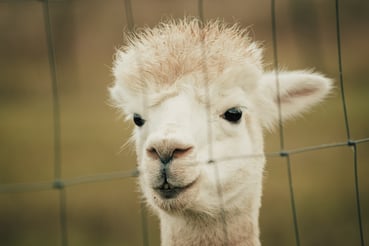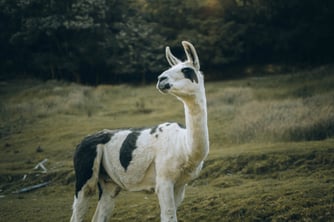Protecting your Herd
A llama provides an imposing and somewhat foreign presence in the modern farmyard. They have an odd, disarming call that keeps predators at bay and sounds an alarm for your benefit--and for your herd's. In terms of protection, this is reason enough, yet this is only the beginning of their impressive credentials. Interestingly, llamas are respectful of a fence and their territory within it. You'll find descriptions of appropriate fencing for your barnyard below.
Llamas May Be Your Answer
Ranchers are overwhelmingly positive about keeping llamas, chiefly in economic terms: loss to predation is dramatically reduced, particularly for sheep farmers.
Llamas are naturally suspicious of and aggressive to dogs, foxes, coyotes, and wolves.
They appear threatening, have unique methods of defense, and are able to kill these powerful predators. The best specimens for guarding pastures are gelded males or females that have been bred and become protective. An open, fenced pasture is preferred, as hilly terrain can result in the llamas being separated from the herd, reducing protection. Llamas like to have the long view.
High Alert
You will find that their awareness of potential invaders is acute. They're constantly checking the periphery of your fenced area. Scan through this video and watch just a bit to see how alert a llama is while it surveys the area:
Behavior
Llamas make a welcome companion to your herd as they integrate with pasture animals naturally and in many cases simply become one of the herd. They are very tolerant of their field companions, working well with cows, sheep, poultry, and goats. However, in a shared pasture, goats have parasites that can be damaging to llamas, so this must be monitored. They can be attentive to lambs and particularly watchful of newborns. Ranchers generally report that their predation problems are completely or substantially eliminated. It is said by some that two or more llamas will sometimes bond with each other and ignore the sheep but this generally untrue. Llamas are social animals and should have at least one partner of the same sex--two females or two gelded males.
Llamas are not aggressive and are generally docile; often liking to keep a few feet of distance but not threatened by humans. They may spit when provoked. Their spitting is unpleasant, more like a regurgitation, but much more rare than thought, usually reserved for an extreme threat and rarely done to their near and dears--meaning you. Respect their need for distance or they may throw a sideways kick to warn you off.
A Few Basics
Their coat is not prized like that of an alpaca, yet does need to be sheered once a year. Also, their toenails--two on each foot--need to be trimmed every 2 to 6 months. Bred as guardian animals, they were also bred as pack animals and for pulling; llamas can carry a lot of weight and capable of traveling through rough terrain. And it may be interesting to note that they often choose one area for droppings in a field, and uniquely, these can be transferred straight onto the garden.
They beat guard dogs in these ways:
- No barking at night
- Respectful of fence boundaries and not interested in escape, unlike dogs
- They eat grass; eating hay when there's no grass--usually whatever the sheep and cows are eating--as opposed to a dog which requires its own separate and costly feeding
- Vet bills are few compared to a dog
- They live longer than guard dogs--15 years and up
If You're Serious
Before you buy one, check out online sources and local want ads for free llamas. Due to varying circumstances, there are often free llamas available or some that are rescues. This cattle rancher has used llamas to great benefit:
Creating an Enclosure
An excellent choice for your pasture is sheep and goat fence, featuring woven 4" x 4" mesh. Made with 12½ gauge high tensile Class 3 galvanized wire for extra long life and rust resistance. Designed with goats and sheep in mind, this fence will work beautifully with the presence of a llama as it is a strong confinement fence. The 4" x 4" mesh deters sheep and goats from putting their heads through the openings. Vertical and horizontal wires are joined by strong stiff stay knots. These smooth-sided knots will not injure animals and give the fence flexibility, minimizing the potential for injury. This fence will conform to hilly terrain, thanks to deeply crimped horizontal wires. Consider Farm and Field Fence, Deer and Wildlife Fence, and Horse Fence as well, depending on your pasturing needs. Add a llama behind an excellent fence and enjoy the enhanced security for your flock and your peace of mind.












![🌲 [Hidden Hero] What Most People Overlook But Can’t Afford To](https://content.cdntwrk.com/mediaproxy?url=https%3A%2F%2Fwww.louispage.com%2Fhs-fs%2Fhubfs%2FChatGPT%2520Image%2520Dec%252011%252C%25202025%252C%252009_24_15%2520AM.png%3Fwidth%3D753%26height%3D1130%26name%3DChatGPT%2520Image%2520Dec%252011%252C%25202025%252C%252009_24_15%2520AM.png&size=1&version=1765476183&sig=ab9c3aeedba193e746f2fd0de82eaafb&default=)













